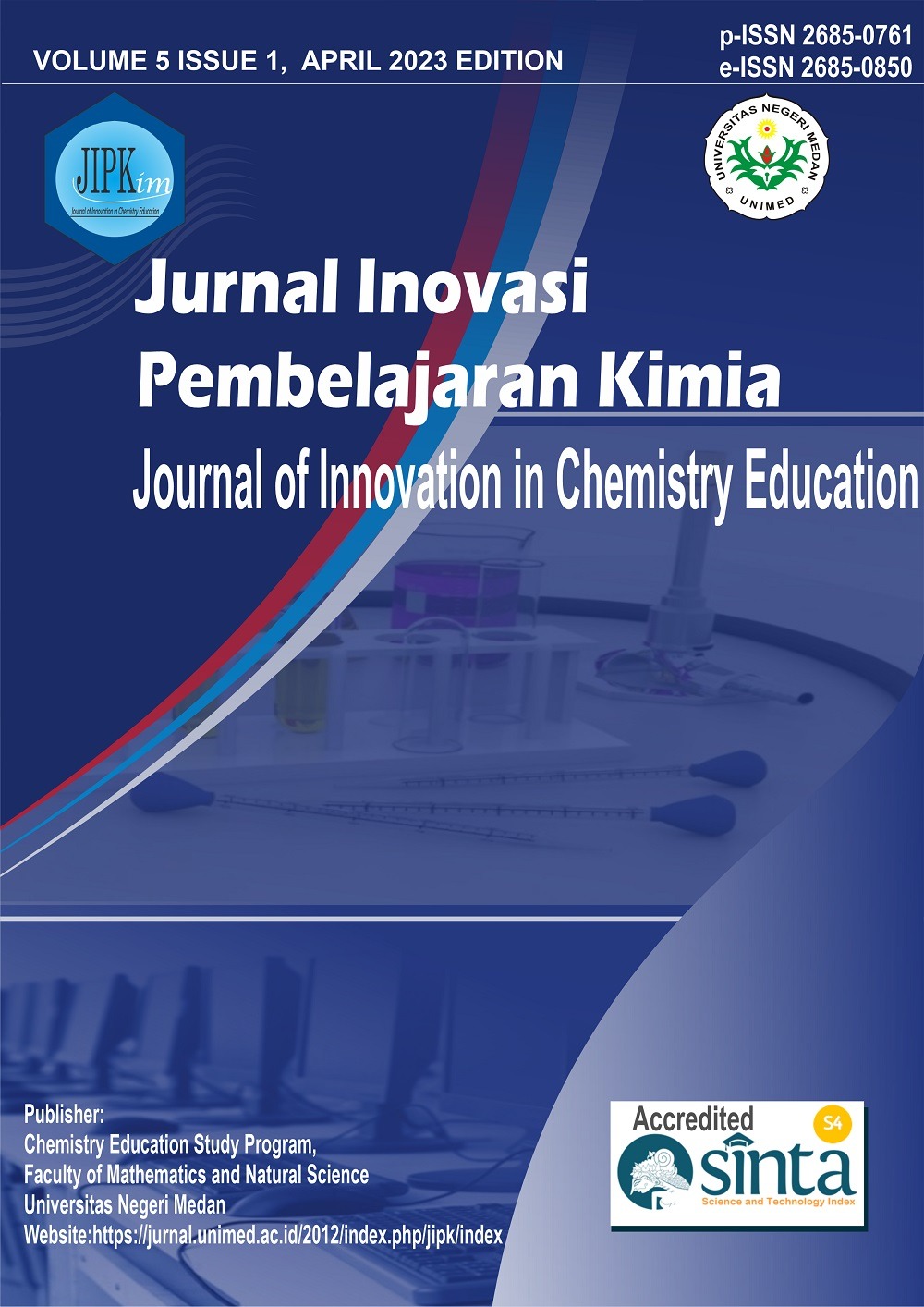Development of Learning Media Integrated with Problem Based Learning Model Using Android-Based Application
DOI:
https://doi.org/10.24114/jipk.v5i1.45009Keywords:
Learning media, Android-based application, Problem Based Learning, 4D Model, Chemical Bonding.Abstract
Technological advances affect education in terms of the use of learning media. This is because the educational process is urged to improve the quality of learning by creating more applicable and interesting learning. Mobile technology can be used as an alternative learning media because the use of mobile devices is very much opens the opportunity in the education process. The aim of this study is to develop a learning media integrated with problem based learning model using android-based application. The development model used is the 4D model which consists of 4 stages, namely Define, Design, Develop and Disseminate. The results of the research are 93.8% agreeing with the existence of android learning media for chemical bonding subjects, the feasibility of the material from the learning media overall obtained 90.1% categorized as œvery valid, and the eligibility of the media as a whole the validator was obtained at 87.39% with the œvery valid category and results of student responses to the developed media as a whole obtained an average value of 80.69% in the œvery good category so that the developed of learning media received a very good response from studentsReferences
Carisma, A. M., & Novita, D. (2017). Penerapan Model Pembelajaran Berbasis Masalah untuk Melatihkan Keterampilan Berpikir Kritis pada Materi Pokok Laju Reaksi Kelas XI di SMA Negeri 1 Manyar Gersik. UNESA Journal of Chemistry Education, 6(1), 111“117.
Cha, S. S., & Seo, B. K. (2018). Smartphone use and smartphone addiction in middle school students in Korea: Prevalence, social networking service, and game use. Health Psychology Open, 5(1). https://doi.org/10.1177/2055102918755046
Dakabesi, D.-, & Luoise, I. S. Y. (2019). The effect of problem based learning model on critical thinking skills in the context of chemical reaction rate. Journal of Education and Learning (EduLearn), 13(3), 395“401. https://doi.org/10.11591/edulearn.v13i3.13887
Darko-Adjei, N. (2019). The use and effect of smartphones in students™ learning activities: Evidence from the University of Ghana, Legon. Library Philosophy and Practice, 2019.
Ifeanyi, I. P., & Chukwuere, J. E. (2018). The impact of using smartphones on the academic performance of undergraduate students. Knowledge Management and E-Learning, 10(3), 290“308. https://doi.org/10.34105/j.kmel.2018.10.017
Komisia, F., & Aloisia Uron Leba, M. (2018). The Effect of Problem Based Learning Model by Animation Media on Student Learning Outcomes in Senior High School on Chemical Bonding Top. 171(Snk), 144“146. https://doi.org/10.2991/snk-18.2018.34
Kurniawan, R. D., & Hidayah, R. (2021a). Development of Android-based Kimi Kimo Adventure Game as Learning Media on Chemical Bonds. International Journal of Active Learning, 6(2), 65“75. http://journal.unnes.ac.id/nju/index.php/ijal
Kurniawan, R. D., & Hidayah, R. (2021b). Validity of Kimi Kimo Adventure Game Based on Android as Learning Media in Chemical Bonds BT - Proceedings of the International Joint Conference on Science and Engineering 2021 (IJCSE 2021). Proceedings of the International Joint Conference on Science and Engineering 2021, 209(Ijcse), 247“253. https://doi.org/10.2991/aer.k.211215.046
Lukman, I., & Ulfa, A. (2020). Meningkatkan Kemampuan Kognitif Kimia Siswa SMA Melalui Pengembangan Media Pembelajaran Berbasis Android. JINOTEP (Jurnal Inovasi Dan Teknologi Pembelajaran): Kajian Dan Riset Dalam Teknologi Pembelajaran, 7(2), 157“164. https://doi.org/10.17977/um031v7i22020p157
Mahartika, I., Afrianis, N., & Yuhelman, N. (2020). Analisis Kebutuhan Chemistry Games (CGs) pada Pembelajaran Kimia di SMA/MA Kota Pekanbaru. Journal of Natural Science and Integration, 3(1), 35. https://doi.org/10.24014/jnsi.v3i1.9347
Mugitsah, A., Irwansyah, F. S., & Subarkah, C. Z. (2020). Chemistry Acoustic (Chemcoustic): Android Based Application for Fun Chemistry Learning. Journal of Physics: Conference Series, 1563(1). https://doi.org/10.1088/1742-6596/1563/1/012031
Novaliendry, D., Darmi, R., Hendriyani, Y., Nor, M., & Azman, A. (2020). Smart Learning Media Based on Android Technology. International Journal of Innovation, Creativity and Change., 12(11), 715“735.
Okta Priantini, D. A. M. M. (2021). The Development Of Teaching Video Media Based On Tri Kaya Parisudha In Educational Psychology Courses. Journal of Education Technology, 4(4), 448. https://doi.org/10.23887/jet.v4i4.29608
Putra, P. S., Asi, N. B., Anggraeni, M. E., & Karelius. (2020). Development of android-based chemistry learning media for experimenting. Journal of Physics: Conference Series, 1422(1). https://doi.org/10.1088/1742-6596/1422/1/012037
Ramdhani, M. A., & Muhammadiyah, H. (2015). Proceeding International Conference of Islamic Education: Reforms, Prospects and Challenges Faculty of Tarbiyah and Teaching Training The Criteria of Learning Media Selection for Character Education in Higher Education. Proceeding International Conference of Islamic Education: Reforms, Prospects and Challenges Faculty of Tarbiyah and Teaching Training The Criteria of Learning Media Selection for Character Education in Higher Education, 174“182.
Saputra, D., Gürbüz, B., & Haryani, H. (2021a). Android-based Animation for Chemical Elements and Experiments as an Interactive Learning Media. Journal of Science Learning, 4(2), 185“191. https://doi.org/10.17509/jsl.v4i2.28787
Saputra, D., Gürbüz, B., & Haryani, H. (2021b). Android-based Animation for Chemical Elements and Experiments as an Interactive Learning Media. Journal of Science Learning, 4(2), 185“191. https://doi.org/10.17509/jsl.v4i2.28787
Wardani, D. L., Degeng, I. N. S., & Cholid, A. (2019). Developing Interactive Multimedia Model 4D for Teaching Natural Science Subject. International Journal of Educational Research, 7(1), 63“72. www.ijern.com
Zulfadhilah, M., Hidayah, N., & Syahid, M. (2020). Design an Android-based Chemical Bond Application. International Journal of Computer Applications, 177(29), 1“5. https://doi.org/10.5120/ijca2020919754

